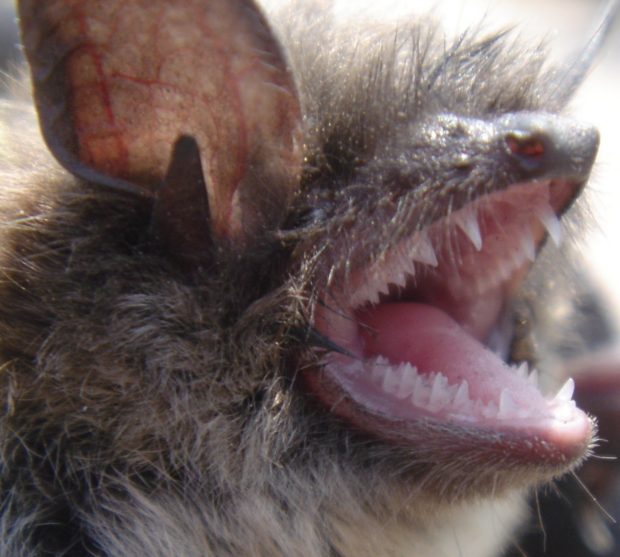The rabies virus is once again in the news as the Halton Region Health Department has confirmed a case of rabies in a bat found in Oakville last week.
The discovery comes on the heels of a separate rabies incident involving a bat found by students on an elementary school playground in Niagara Falls and over 120 positive cases of the virus in raccoons and skunks in the Hamilton area since December 2015.
There are numerous myths and misconceptions associated with rabies and for many people the disease evokes images of hyper aggressive animals frothing at the mouth. When it comes to the health of your family and pets it’s important to know the facts.

A bat hanging from a window screen inside a home
What is rabies?
Rabies is a viral disease that is spread primarily through the saliva of an infected mammal, most often through a bite, scratch or saliva spray. The virus infects the central nervous system causing fatal swelling of the brain.
Early symptoms are similar to the flu and can include weakness, fatigue and fever. As the disease progresses the symptoms become more specific and the sufferer may experience confusion, anxiety, aggression and difficulty swallowing which leads to excessive salivation.
Fortunately, illness in humans can be prevented through post-exposure rabies vaccines but only before later symptoms begin to show. Reacting quickly is key as once rabies specific symptoms set in, the disease is nearly 100% fatal.
How to prevent rabies
Rabies symptoms in wildlife can take many forms which can make it difficult to tell if a wild animal has the virus.
Halton Region Health Department is advising Oakville residents to avoid contact with bats and other wild animals. Anyone who has been exposed to a wild animal should see their doctor immediately and report the incident to public health.

Bats huddled together inside a soffit
Over the past several years, almost all cases of human rabies have been the result of a contact with bats. It is not uncommon for Little Brown Bats and Big Brown Bats to roost inside the attics and walls of houses which increases the odds of exposure.
Summer is the time of year when bats are at their most active and for bats that normally reside in the attic to accidentally make their way into the living space of a home. If a bat enters the living space there is a distinct possibility of it coming into contact with your family or pets.
Bats have very small, narrow teeth that can make bites difficult to detect especially if the person is sleeping.

Bats have very sharp teeth that can make bites difficult to detect
Bat Proof your Home
If you find a bat flying around the inside of your home, it most likely belongs to a colony living elsewhere in the structure of the house. While bats are not known to be aggressive they are capable of biting in self defense. Do not attempt to capture or kill the bat as this will put you at risk of potentially coming into contact with the rabies virus.
Your best bet is to confine the bat to a particular area by closing doors and placing a towel at the bottom of the frame to prevent the bat from escaping.
Call a professional wildlife removal specialist with the skill and equipment necessary to safely remove the bat. If you suspect the bat has come into contact with a family member or pet then consult a healthcare professional immediately and contact the public health department.
Wildlife removal specialists like Skedaddle Humane Wildlife Control have the knowledge and experience to humane and effectively get rid of your bats. They will inspect your attic and the exterior of your home to determine if there is a colony inside and how they are entering. From there they can develop a plan to humanely remove the bats from your attic and prevent their re-entry.
If you’ve experienced a bat inside your home it’s important to have your house inspected by a qualified professional. Don’t delay, call Skedaddle Humane Wildlife Control today – (905) 858-3379!


